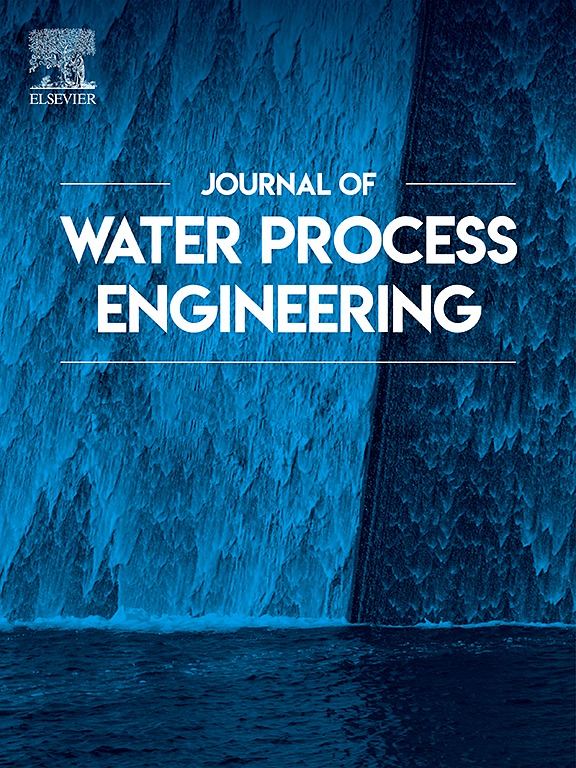Bio-fabrication of multifunctional CuO-ZnO nanocomposites for improved biomedical and industrial wastewater purification by experimental and molecular docking computational investigation
IF 6.3
2区 工程技术
Q1 ENGINEERING, CHEMICAL
引用次数: 0
Abstract
The current research focused on the fabrication of copper oxide‑zinc oxide nanocomposites (CuO-ZnO NCs) using Ceropegia debilis plant extract. The green fabricated material was characterized to analyse its structural, optical, and morphological properties. The NCs showed maximum absorbance at 372 nm with an energy gap of 2.95 eV. XRD and XPS analysis confirms the existence of Cu and Zn in the fabricated CuO-ZnO NCs. The peak indexed at 36.2⸰ revealed the crystalline nature of NCs. The SEM and TEM studies revealed the spherical morphology with an average size of 36.2 nm and 31.1 nm, respectively. Zeta potential analysis confirms the stability of CuO-ZnO NCs with a negative potential of −21.3. CuO-ZnO NCs exhibit good antimicrobial properties against Staphylococcus aureus and Trichoderma viride. Moreover, NCs showed remarkable induced apoptosis against A549 and MCF-7 with an IC50 27.25 μg/mL and 24.35 μg/mL, respectively. A molecular docking computational study was used to validate the experimental antibacterial efficiency of both plant extract and NCs. The protein, dihydropteroate synthase showed the highest binding efficiency of −7.27 Kcal/mol and -5.90 Kcal/mol for bioactive molecule and CuO-ZnO NCs, respectively. Furthermore, photocatalytic efficiency was examined through the breakdown of the toxic pollutant methylene blue under sunlight irradiation, the degradation efficiency to be 96.1 % after 90 min of irradiation. The results revealed excellent photocatalytic properties of CuO-ZnO NCs due to improved charge separation and reduced recombination rates. Hence, the present study suggests that the synthesized CuO-ZnO NCs through the green route hold promise for environmental remediation and biological applications.

求助全文
约1分钟内获得全文
求助全文
来源期刊

Journal of water process engineering
Biochemistry, Genetics and Molecular Biology-Biotechnology
CiteScore
10.70
自引率
8.60%
发文量
846
审稿时长
24 days
期刊介绍:
The Journal of Water Process Engineering aims to publish refereed, high-quality research papers with significant novelty and impact in all areas of the engineering of water and wastewater processing . Papers on advanced and novel treatment processes and technologies are particularly welcome. The Journal considers papers in areas such as nanotechnology and biotechnology applications in water, novel oxidation and separation processes, membrane processes (except those for desalination) , catalytic processes for the removal of water contaminants, sustainable processes, water reuse and recycling, water use and wastewater minimization, integrated/hybrid technology, process modeling of water treatment and novel treatment processes. Submissions on the subject of adsorbents, including standard measurements of adsorption kinetics and equilibrium will only be considered if there is a genuine case for novelty and contribution, for example highly novel, sustainable adsorbents and their use: papers on activated carbon-type materials derived from natural matter, or surfactant-modified clays and related minerals, would not fulfil this criterion. The Journal particularly welcomes contributions involving environmentally, economically and socially sustainable technology for water treatment, including those which are energy-efficient, with minimal or no chemical consumption, and capable of water recycling and reuse that minimizes the direct disposal of wastewater to the aquatic environment. Papers that describe novel ideas for solving issues related to water quality and availability are also welcome, as are those that show the transfer of techniques from other disciplines. The Journal will consider papers dealing with processes for various water matrices including drinking water (except desalination), domestic, urban and industrial wastewaters, in addition to their residues. It is expected that the journal will be of particular relevance to chemical and process engineers working in the field. The Journal welcomes Full Text papers, Short Communications, State-of-the-Art Reviews and Letters to Editors and Case Studies
 求助内容:
求助内容: 应助结果提醒方式:
应助结果提醒方式:


